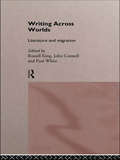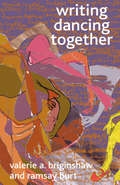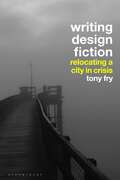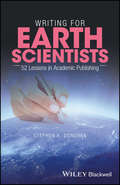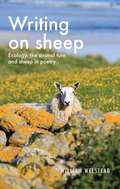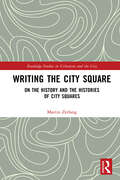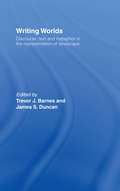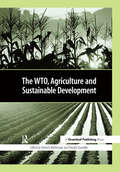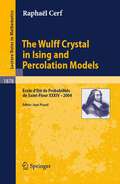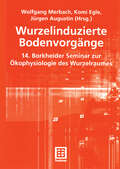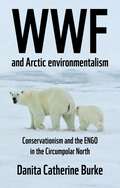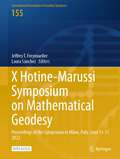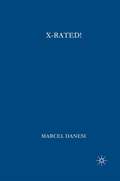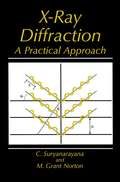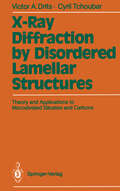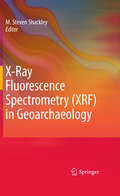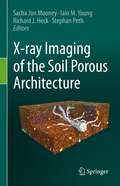- Table View
- List View
Writing Across Worlds: Literature and Migration
by John Connell Russell King Paul WhiteInternational migration has long been a dominant feature of world literature from both post-industrial and developing countries. The increasing demands of the global economic system and continued political instability in many of the world's region have highlighted this shifting map of the world's peoples.Yet, political concern for the larger scale economic and social impact of migration has effectively obscured the nature of the migratory nature of the migratory experience itself, the emotions and practicalities of departure, travel, arrival and the attempt to rebuild a home.Writing Across Worlds explores an extraordinary range of migration literaturesm from letters and diaries to journalistic articles, autobiographies and fiction, in order to analyse the reality of the migrant's experience. The sheer range of writings - Irish, Friulian, Italian, Jewish and South Asian British, Gastarbeiter literature from Germany, Pied noir, French-Algerian and French West Indian writing, Carribbean novels, Slovene emigrant texts, Japanese-Canadian writing, migration in American novels, narratives from Australia, South Africa, Samoa and others - illustrate the diversity of global migratory experience and emphasise the social context of literature.The geographic and literary range of Writing Across Worlds makes this collection an invaluable analysis of migration, giving voice to the hope, pain, nostalgia and triumph of lives lived in other places.
Writing Across Worlds: Literature and Migration
by Russell King John Connell Paul WhiteInternational migration has long been a dominant feature of world literature from both post-industrial and developing countries. The increasing demands of the global economic system and continued political instability in many of the world's region have highlighted this shifting map of the world's peoples.Yet, political concern for the larger scale economic and social impact of migration has effectively obscured the nature of the migratory nature of the migratory experience itself, the emotions and practicalities of departure, travel, arrival and the attempt to rebuild a home.Writing Across Worlds explores an extraordinary range of migration literaturesm from letters and diaries to journalistic articles, autobiographies and fiction, in order to analyse the reality of the migrant's experience. The sheer range of writings - Irish, Friulian, Italian, Jewish and South Asian British, Gastarbeiter literature from Germany, Pied noir, French-Algerian and French West Indian writing, Carribbean novels, Slovene emigrant texts, Japanese-Canadian writing, migration in American novels, narratives from Australia, South Africa, Samoa and others - illustrate the diversity of global migratory experience and emphasise the social context of literature.The geographic and literary range of Writing Across Worlds makes this collection an invaluable analysis of migration, giving voice to the hope, pain, nostalgia and triumph of lives lived in other places.
Writing Dancing Together
by V. Briginshaw Ramsay BurtWith a political agenda foregrounding collaborative practice to promote ethical relations, these individually and joint written essays and interviews discuss dances often with visual art, theatre, film and music, drawing on continental philosophy to explore notions of space, time, identity, sensation, memory and ethics.
Writing Design Fiction: Relocating a City in Crisis
by Tony FryWritten by leading design philosopher Tony Fry, Writing Design Fiction: Relocating a City in Crisis is both an introduction to the power of “design fiction” in the design process, and a novella-length work of fiction in itself-telling the dramatic story of the relocation of the City of Harshon.Set in the near future, Harshon, a delta city, is facing environmental catastrophe due to rising sea levels-consequently, a decision is made to relocate the entire city inland. A diverse cast of voices-including an architect, a journalist, an economist, a construction worker, and residents-narrate the extraordinary challenges and complexities which follow. This work presents a real-world scenario which, in coming decades, will face many of the world's cities. The fictional format provides a novel way of exploring the very serious inherent technical, social, political, economic and cultural challenges. The story provides a rehearsal of the design challenges which are likely to face architects, planners, and designers in an uncertain global future.“Design fiction” is a fast-growing area within design and architecture, increasingly deployed as a serious methodology by designers as a tool in scenario planning. Writing Design Fiction takes the practice to a higher level conceptually and theoretically, but also practically. The book is divided into four parts, with the fictional narrative bookended by further critical analysis. Part One shows how a critique of existing modes of design fiction can lead to more grounded and critical thinking and practice. Part Three critically reflects on the narrative, while Part Four presents the practical application of the second order design fiction approach. This book demonstrates the value of a more developed mode of design fiction to students, professional designers and architects across the breadth of design practices, as well as to other disciplines interested in the future of cities.
Writing Design Fiction: Relocating a City in Crisis
by Tony FryWritten by leading design philosopher Tony Fry, Writing Design Fiction: Relocating a City in Crisis is both an introduction to the power of “design fiction” in the design process, and a novella-length work of fiction in itself-telling the dramatic story of the relocation of the City of Harshon.Set in the near future, Harshon, a delta city, is facing environmental catastrophe due to rising sea levels-consequently, a decision is made to relocate the entire city inland. A diverse cast of voices-including an architect, a journalist, an economist, a construction worker, and residents-narrate the extraordinary challenges and complexities which follow. This work presents a real-world scenario which, in coming decades, will face many of the world's cities. The fictional format provides a novel way of exploring the very serious inherent technical, social, political, economic and cultural challenges. The story provides a rehearsal of the design challenges which are likely to face architects, planners, and designers in an uncertain global future.“Design fiction” is a fast-growing area within design and architecture, increasingly deployed as a serious methodology by designers as a tool in scenario planning. Writing Design Fiction takes the practice to a higher level conceptually and theoretically, but also practically. The book is divided into four parts, with the fictional narrative bookended by further critical analysis. Part One shows how a critique of existing modes of design fiction can lead to more grounded and critical thinking and practice. Part Three critically reflects on the narrative, while Part Four presents the practical application of the second order design fiction approach. This book demonstrates the value of a more developed mode of design fiction to students, professional designers and architects across the breadth of design practices, as well as to other disciplines interested in the future of cities.
Writing for Earth Scientists: 52 Lessons in Academic Publishing
by Stephen K. DonovanThe time has come. You are an Earth scientist. You’ve spent weeks, months, years working on this project – now is the time to pull it together for publication. You might be writing an undergraduate or graduate thesis, a research paper for a leading journal, a note for the newsletter of the local amateur scientific society, a book review or an abstract for a specialist geological conference. How do you make the transition from promising unpublished researcher to established academic author? Of course, the phrase ‘academic publishing’ covers a multitude of sins; monographs, research papers, book reviews, conference abstracts or whatever each requires a different approach. You have to decide what it is you are going to write and where to publish it. There are co-authors, supervisors of your degree, peer reviewers and editors to deal with on the way. But the only way to write like an academic is to write like an academic. . . where do you start? You could do much worse than start here. There are many books on how to write and be published aimed at research students and other aspiring academics. Many of these are readable, comprehensive and provide good advice. This book is composed of numerous short chapters on this subject, all directly relevant to one or more aspects of academic publishing and aimed particularly at the Earth scientists in the broadest sense. Geologists will be encouraged to use the book as much as a reference as a reader, ‘dipping in’ to the chapters that contain relevant tips, hints and comments to enable them to improve the paper that they are currently writing. The book is intended to be informative, readable and, above all, of practical application for all readers. In summary, the volume will be a readable compilation investigating many facets of academic publishing relevant to the Earth sciences. It will be of particular interest to postgraduate students, postdocs and new academics
Writing for Earth Scientists: 52 Lessons in Academic Publishing
by Stephen K. DonovanThe time has come. You are an Earth scientist. You’ve spent weeks, months, years working on this project – now is the time to pull it together for publication. You might be writing an undergraduate or graduate thesis, a research paper for a leading journal, a note for the newsletter of the local amateur scientific society, a book review or an abstract for a specialist geological conference. How do you make the transition from promising unpublished researcher to established academic author? Of course, the phrase ‘academic publishing’ covers a multitude of sins; monographs, research papers, book reviews, conference abstracts or whatever each requires a different approach. You have to decide what it is you are going to write and where to publish it. There are co-authors, supervisors of your degree, peer reviewers and editors to deal with on the way. But the only way to write like an academic is to write like an academic. . . where do you start? You could do much worse than start here. There are many books on how to write and be published aimed at research students and other aspiring academics. Many of these are readable, comprehensive and provide good advice. This book is composed of numerous short chapters on this subject, all directly relevant to one or more aspects of academic publishing and aimed particularly at the Earth scientists in the broadest sense. Geologists will be encouraged to use the book as much as a reference as a reader, ‘dipping in’ to the chapters that contain relevant tips, hints and comments to enable them to improve the paper that they are currently writing. The book is intended to be informative, readable and, above all, of practical application for all readers. In summary, the volume will be a readable compilation investigating many facets of academic publishing relevant to the Earth sciences. It will be of particular interest to postgraduate students, postdocs and new academics
Writing on sheep: Ecology, the animal turn and sheep in poetry
by William WelsteadSheep are marginalised in literary criticism and in discussion of pastoral literature. This book brings an animal studies approach to poetry about sheep that allows for the agency of these sentient beings, that have been associated for humans over ten thousand years. This approach highlights the distinction between wild and domesticated species and the moral dilemma between the goals of animal welfare and those of saving species from extinction. Discussion of mostly contemporary poetry follows a new reading of works from the pastoral and georgic canon. Allowing for the sentience and sociality of this species makes it easier to imagine a natureculture within which to make kin across the species boundary. Reading poetry about sheep has the power to make new meanings as we try to adapt to an increasingly complex and problematic environment.
Writing on sheep: Ecology, the animal turn and sheep in poetry
by William WelsteadSheep are marginalised in literary criticism and in discussion of pastoral literature. This book brings an animal studies approach to poetry about sheep that allows for the agency of these sentient beings, that have been associated for humans over ten thousand years. This approach highlights the distinction between wild and domesticated species and the moral dilemma between the goals of animal welfare and those of saving species from extinction. Discussion of mostly contemporary poetry follows a new reading of works from the pastoral and georgic canon. Allowing for the sentience and sociality of this species makes it easier to imagine a natureculture within which to make kin across the species boundary. Reading poetry about sheep has the power to make new meanings as we try to adapt to an increasingly complex and problematic environment.
Writing the City Square: On the History and the Histories of City Squares (Routledge Studies in Urbanism and the City)
by Martin ZerlangThe history of cities is also the history of city squares. The agora, the forum, the piazza, the plaza: All presuppose the idea of a center. It’s a material and mental phenomenon. Literature is an important part of this history, and the interplay between the square as physical space and the square as literature is the topic of this book. This is an encyclopedic book combining an overview of the history of city squares with a plethora of analytical examples of its reflection in literature: Literature uses the city square as a frame; city squares serve as frames for drama; novels and other kinds of literature comment on city squares; city squares are sources of inspiration for all sorts of literary activities. Socrates in the agora, Cicero in the Forum, Calderón in the Plaza Mayor, Corneille in the Place Royale, Richardson in Grosvenor Square, James in Washington Square, Woolf in Bloomsbury Square, Döblin and Gröschner in Alexanderplatz, Rodoreda in Diamond Square in Barcelona, DeLillo in Times Square, Al Aswany in Tahrir Square, the Maidanistas in the Maidan of Kyiv: These are just some of the examples presented and analyzed in this book. The book is of direct interest for researchers, students, and professionals such as architects and urban planners, but it is written in a way that makes it accessible for all readers with an interest in urban culture, architecture, history, literature, and cultural studies.
Writing the City Square: On the History and the Histories of City Squares (Routledge Studies in Urbanism and the City)
by Martin ZerlangThe history of cities is also the history of city squares. The agora, the forum, the piazza, the plaza: All presuppose the idea of a center. It’s a material and mental phenomenon. Literature is an important part of this history, and the interplay between the square as physical space and the square as literature is the topic of this book. This is an encyclopedic book combining an overview of the history of city squares with a plethora of analytical examples of its reflection in literature: Literature uses the city square as a frame; city squares serve as frames for drama; novels and other kinds of literature comment on city squares; city squares are sources of inspiration for all sorts of literary activities. Socrates in the agora, Cicero in the Forum, Calderón in the Plaza Mayor, Corneille in the Place Royale, Richardson in Grosvenor Square, James in Washington Square, Woolf in Bloomsbury Square, Döblin and Gröschner in Alexanderplatz, Rodoreda in Diamond Square in Barcelona, DeLillo in Times Square, Al Aswany in Tahrir Square, the Maidanistas in the Maidan of Kyiv: These are just some of the examples presented and analyzed in this book. The book is of direct interest for researchers, students, and professionals such as architects and urban planners, but it is written in a way that makes it accessible for all readers with an interest in urban culture, architecture, history, literature, and cultural studies.
Writing Worlds: Discourse, Text and Metaphor in the Representation of Landscape
by Trevor J. Barnes James S. DuncanWriting Worlds represents the first systematic attempt to apply poststructuralist ideas to landscape representation. Landscape - city, countryside and wilderness - is explored through the discourse of economics, geopolitics and urban planning, travellers descriptions, propaganda maps, cartography and geometry, poetry and painting. The book aims to deconstruct geographical representation in order to explore the dynamics of power in the way we see the world.
Writing Worlds: Discourse, Text and Metaphor in the Representation of Landscape
by Trevor J. Barnes James S. DuncanWriting Worlds represents the first systematic attempt to apply poststructuralist ideas to landscape representation. Landscape - city, countryside and wilderness - is explored through the discourse of economics, geopolitics and urban planning, travellers descriptions, propaganda maps, cartography and geometry, poetry and painting. The book aims to deconstruct geographical representation in order to explore the dynamics of power in the way we see the world.
The WTO, Agriculture and Sustainable Development
by Heinrich Wohlmeyer Theodor QuendlerDespite the Doha declaration of November 2001, the failure to start a new round of global trade negotiations at Seattle in December 1999 and the hostility of protesters to the trade liberalization process and growing global economic and social disparities was a wake-up call for the World Trade Organisation (WTO). The ambitious goal of this ground-breaking book is to identify the strengths and weaknesses of liberalized world trade, in particular in the agricultural sector, and to investigate to what extent the current WTO agreements provide the necessary fail-safe devices to react to trade-related negative impacts on sustainability, environmental protection and food security. The background and interrelationship between the WTO, the tenets of sustainable development and the unique features of the agriculture and forestry sectors are explored, and conclusions regarding the deficits of the world trade system and its conflicts with basic societal goals – such as sustainability – are drawn. Agriculture and forestry have a particular affinity with what the authors call "strong sustainability" and are to be among the major agenda items in forthcoming WTO negotiations. The book proposes that sustainable agricultural production techniques such as integrated and organic farming provide a series of related services to community and environment which could be severely prejudiced by wholesale trade liberalization and the imposition of the large-scale production methods of the mega-trade giants of the USA and Europe. And yet the concept of sustainability is referred to only tangentially in the existing WTO agenda. The WTO, Agriculture and Sustainable Development argues that, without a formal recognition of this failing, the premise that free trade is inherently advantageous for all countries is a falsehood. Further, unfettered liberalization is unsustainable and a social and environmental multilateral framework must be agreed to reinterpret or adapt a host of WTO regulations that are at odds with sustainable development. The core problem is that, under the current system, import duties can only be differentiated by direct goods and services and not by their means of production – sustainable or otherwise. Therefore, a range of environmental policy measures in the agricultural sector, such as the consideration of product life-cycles, the internalization of external costs and a coupling of trade liberalization with ecological obligations are proposed by the authors. In addition, they argue that unsustainable economic short-termism must be curbed and the use of the stick of trade sanctions and the carrot of financial benefits for good environmental performance be permitted to promote sustainable agricultural practices. This book will contribute greatly in addressing the lack of basic theoretical arguments at the intersection between trade and sustainable development – a failing that has already been bemoaned by trade policy-makers. It is highly recommended reading for all those involved or interested in the WTO negotiations, whether from multilateral organizations, governments, industry or civil society.
The WTO, Agriculture and Sustainable Development
by Heinrich Wohlmeyer Theodor QuendlerDespite the Doha declaration of November 2001, the failure to start a new round of global trade negotiations at Seattle in December 1999 and the hostility of protesters to the trade liberalization process and growing global economic and social disparities was a wake-up call for the World Trade Organisation (WTO). The ambitious goal of this ground-breaking book is to identify the strengths and weaknesses of liberalized world trade, in particular in the agricultural sector, and to investigate to what extent the current WTO agreements provide the necessary fail-safe devices to react to trade-related negative impacts on sustainability, environmental protection and food security. The background and interrelationship between the WTO, the tenets of sustainable development and the unique features of the agriculture and forestry sectors are explored, and conclusions regarding the deficits of the world trade system and its conflicts with basic societal goals – such as sustainability – are drawn. Agriculture and forestry have a particular affinity with what the authors call "strong sustainability" and are to be among the major agenda items in forthcoming WTO negotiations. The book proposes that sustainable agricultural production techniques such as integrated and organic farming provide a series of related services to community and environment which could be severely prejudiced by wholesale trade liberalization and the imposition of the large-scale production methods of the mega-trade giants of the USA and Europe. And yet the concept of sustainability is referred to only tangentially in the existing WTO agenda. The WTO, Agriculture and Sustainable Development argues that, without a formal recognition of this failing, the premise that free trade is inherently advantageous for all countries is a falsehood. Further, unfettered liberalization is unsustainable and a social and environmental multilateral framework must be agreed to reinterpret or adapt a host of WTO regulations that are at odds with sustainable development. The core problem is that, under the current system, import duties can only be differentiated by direct goods and services and not by their means of production – sustainable or otherwise. Therefore, a range of environmental policy measures in the agricultural sector, such as the consideration of product life-cycles, the internalization of external costs and a coupling of trade liberalization with ecological obligations are proposed by the authors. In addition, they argue that unsustainable economic short-termism must be curbed and the use of the stick of trade sanctions and the carrot of financial benefits for good environmental performance be permitted to promote sustainable agricultural practices. This book will contribute greatly in addressing the lack of basic theoretical arguments at the intersection between trade and sustainable development – a failing that has already been bemoaned by trade policy-makers. It is highly recommended reading for all those involved or interested in the WTO negotiations, whether from multilateral organizations, governments, industry or civil society.
The Wulff Crystal in Ising and Percolation Models: Ecole d'Eté de Probabilités de Saint-Flour XXXIV - 2004 (Lecture Notes in Mathematics #1878)
by Raphaël CerfThis volume is a synopsis of recent works aiming at a mathematically rigorous justification of the phase coexistence phenomenon, starting from a microscopic model. It is intended to be self-contained. Those proofs that can be found only in research papers have been included, whereas results for which the proofs can be found in classical textbooks are only quoted.
Wurzelinduzierte Bodenvorgänge: 14. Borkheider Seminar zur Ökophysiologie des Wurzelraumes
by Wolfgang Merbach Komi Egle Jürgen AugustinVon einer nachhaltigen Landnutzung wird neben der Erzeugung hochwertiger Produkte auch die Bewahrung der Funktionsfähigkeit von Ökosystemen erwartet. Vor allem die Entwicklung der Pflanzen und des durchwurzelten Bodens kennzeichnen naturnahe als auch agrarische Ökosysteme. Um deren Belastbarkeit und Stabilität einschätzen zu können, sind Kenntnisse über die komplexen Prozesse im Wurzelraum von großem Interesse. Dieses Buch soll einen Beitrag zur Erweiterung unseres Wissens über die Strukturen, Funktionen und Prozesse im Wurzelraum leisten.
WWF and Arctic environmentalism: Conservationism and the ENGO in the Circumpolar North
by Danita Catherine BurkeBased on interviews with WWF representatives and other experts, this book explores WWF’s approach to engagement in the Circumpolar North. It argues that the foundation of WWF’s success in circumpolar engagement is based on four inter-related pillars: legacy, networks, scientific research and communication style. The book argues that WWF has made remarkable strides to distinguish itself in Arctic and northern engagement through its Global Arctic Programme and national organisations and associated offices in the Arctic states. However, WWF’s work and successes are illustrative of the need for environmental and animal rights organisations to adopt a long-term strategy that show commitment to helping in the Arctic and North which factor in the needs and desires of northerners if they want their work to resonate and be welcomed by key northern audiences.
WWF and Arctic environmentalism: Conservationism and the ENGO in the Circumpolar North
by Danita Catherine BurkeBased on interviews with WWF representatives and other experts, this book explores WWF’s approach to engagement in the Circumpolar North. It argues that the foundation of WWF’s success in circumpolar engagement is based on four inter-related pillars: legacy, networks, scientific research and communication style. The book argues that WWF has made remarkable strides to distinguish itself in Arctic and northern engagement through its Global Arctic Programme and national organisations and associated offices in the Arctic states. However, WWF’s work and successes are illustrative of the need for environmental and animal rights organisations to adopt a long-term strategy that show commitment to helping in the Arctic and North which factor in the needs and desires of northerners if they want their work to resonate and be welcomed by key northern audiences.
X Hotine-Marussi Symposium on Mathematical Geodesy: Proceedings of the Symposium in Milan, Italy, June 13-17, 2022 (International Association of Geodesy Symposia #155)
by Jeffrey T. Freymueller Laura SánchezThis open access volume contains the proceedings of the X Hotine-Marussi Symposium on Mathematical Geodesy which was held from 13 to 17 June 2022 at the Politecnico di Milano, Milan, Italy. Since 2006 the series of the Hotine-Marussi Symposia has been under the responsibility of the Inter-Commission Committee on Theory (ICCT) within the International Association of Geodesy (IAG). The ICCT organized the last five Hotine-Marussi Symposia held in Wuhan (2006), Rome (2009, 2013 and 2018), and Milan (2022). The overall goal of the ICCT and Hotine-Marussi Symposia has always been to advance geodetic theory which is indeed documented by the 22 research articles published in these proceedings. The jubilee X Hotine-Marussi Symposium was organized in 10 topical sessions covering all parts of geodetic theory including reference frames, gravity field modelling, adjustment theory, height systems, time series analysis, or advanced numerical methods. In total, 60 participants attended the Symposium who delivered 62 oral and 18 poster presentations. During a special session, five invited speakers discussed two basic concepts of physical geodesy – geoid and quasigeoid.
X-Rated!: The Power of Mythic Symbolism in Popular Culture
by Marcel DanesiMany attack pop culture as a crude 'sexual' and 'celebrity-based' culture that is purportedly bringing about the end of moral values. Renowned semiotician Marcel Danesi adds his signature insight to the debate by delving deep into pop culture through a consideration of symbols. Danesi's treatment of letters, such as the X in 'X-Rated,' the 'i' in 'iPod,' and other such symbols, reveals an ancient mythic structure that blends the sacred and profane dimensions of human psychic life. Danesi takes the reader on a remarkable exploration of the radical turns in American society, a society in which the search for pleasure and sexual expression often reign supreme. X-Rated! is a fascinating trip through what gives pop culture its secret appeal.
X-Ray Diffraction: A Practical Approach
by C. Suryanarayana M. Grant NortonIn this, the only book available to combine both theoretical and practical aspects of x-ray diffraction, the authors emphasize a "hands on" approach through experiments and examples based on actual laboratory data. Part I presents the basics of x-ray diffraction and explains its use in obtaining structural and chemical information. In Part II, eight experimental modules enable the students to gain an appreciation for what information can be obtained by x-ray diffraction and how to interpret it. Examples from all classes of materials -- metals, ceramics, semiconductors, and polymers -- are included. Diffraction patterns and Bragg angles are provided for students without diffractometers. 192 illustrations.
X-Ray Diffraction by Disordered Lamellar Structures: Theory and Applications to Microdivided Silicates and Carbons
by Victor A. Drits Cyril TchoubarNew methods for the determination of the nature, proportion, and distribution of structural defects in microcrystallized lamellar systems are of utmost importance not only to experimentalists but also to theoreticians. Mathematical formalism - indispensable for such analyses - is well-illustrated by various examples, allowing this method to be easily adopted and even to be applied to other solids with lamellar or pseudo-lamellar structures.
X-Ray Fluorescence Spectrometry (XRF) in Geoarchaeology
by M. Steven ShackleySince the 1960s, x-ray fluorescence spectrometry (XRF), both wavelength and energy-dispersive have served as the workhorse for non-destructive and destructive analyses of archaeological materials. Recently eclipsed by other instrumentation such as LA-ICP-MS, XRF remains the mainstay of non-destructive chemical analyses in archaeology, particularly for volcanic rocks, and most particularly for obsidian. In a world where heritage and repatriation issues drive archaeological method and theory, XRF remains an important tool for understanding the human past, and will remain so for decades to come.Currently, there is no comprehensive book in XRF applications in archaeology at a time when the applications of portable XRF and desktop XRF instrumentation are exploding particularly in anthropology and archaeology departments worldwide. The contributors to this volume are the experts in the field, and most are at the forefront of the newest applications of XRF to archaeological problems. It covers all relevant aspects of the field for those using the newest XRF technologies to deal with very current issues in archaeology.
X-ray Imaging of the Soil Porous Architecture
by Sacha Jon Mooney Iain M. Young Richard J. Heck Stephan PethThe advent of X-ray Computed Tomography (CT) as a tool for the soil sciences almost 40 years ago has revolutionised the field. Soil is the fragile, thin layer of material that exists above earth’s geological substrates upon which so much of life on earth depends. However a major limitation to our understanding of how soils behave and function is due to its complex, opaque structure that hinders our ability to assess its porous architecture without disturbance. X-ray imagery has facilitated the ability to truly observe soil as it exists in three dimensions and across contrasting spatial and temporal scales in the field in an undisturbed fashion. This book gives a comprehensive overview of the “state of the art” in a variety of application areas where this type of imaging is used, including soil water physics and hydrology, agronomic management of soils, and soil-plant-microbe interactions. It provides the necessary details for entry level readers in the crucial areas of sample preparation, scanner optimisation and image processing and analysis. Drawing on experts across the globe, from both academia and industry, the book covers the necessary “dos and don’ts”, but also offers insights into the future of both technology and science. The wider application of the book is provided by dedicated chapters on how the data from such imagery can be incorporated into models and how the technology can be interfaced with other relevant technical applications. The book ends with a future outlook from the four editors, each of whom has over 20 years of experience in the application of X-ray CT to soil science.
